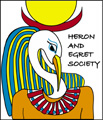

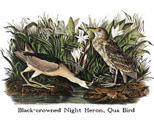
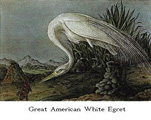
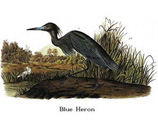

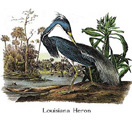
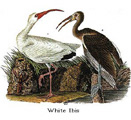
 |
 |
 |
 |
 |
 |
 |
 |
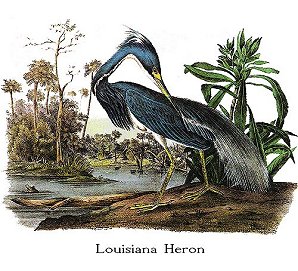 Family XXXVIII.ARDEINAE. HERONS. Genus ARDEA LUDOVICIANA, Wils.
[Egretta tricolor.]
Family XXXVIII.ARDEINAE. HERONS. Genus ARDEA LUDOVICIANA, Wils.
[Egretta tricolor.]
Delicate in form, beautiful in plumage, and
graceful in its movements, I never see this interesting Heron, without calling
it the Lady of the Waters. Watch its motions, as it leisurely walks over the
pure sand beaches of the coast of Florida, arrayed in the full beauty of its
spring plumage. Its pendent crest exhibits its glossy tints, its train falls
gracefully over a well defined tail, and the tempered hues of its back and wings
contrast with those of its lower parts. Its measured steps are so light that
they leave no impression on the sand, and with its keen eye it views every object
around with the most perfect accuracy. See, it has spied a small fly lurking
on a blade of grass, it silently runs a few steps, and with the sharp point
of its bill it has already secured the prey. The minnow just escaped from the
pursuit of some larger fish has almost rushed upon the beach for safety; but
the quick eye of the Heron has observed its motions, and in an instant it is
swallowed alive. Among the herbage yet dripping with dew the beautiful bird
picks its steps. Not a snail can escape its keen search, and as it moves around
the muddy pool, it secures each water lizard that occurs. Now the sun's rays
have dried up the dews, the flowers begin to droop, the woodland choristers
have ended their morning concert, and like them, the Heron, fatigued with its
exertions, seeks a place of repose under the boughs of the nearest bush, where
it may in safety await the coolness of the evening. Then for a short while it
again searches for food. Little difficulty does it experience in this; and at
length, with the last glimpse of day, it opens its wings, and flies off towards
its well-known roosting-place, where it spends the night contented and happy.
This species, which is a constant resident in the southern parts of the peninsula
of the Floridas, seldom rambles far from its haunts during the winter season,
being rarely seen at that period beyond Savannah in Georgia to the eastward.
To the west it extends to the broad sedgy flats bordering the mouths of the
Mississippi, along the whole Gulf of Mexico, and perhaps much farther south.
In the beginning of spring, it is found abundantly in the Carolinas, and sometimes
as far east as Maryland, or up the Mississippi as high as Natchez. You never
find it far inland: perhaps forty miles would be a considerable distance at
any time of the year. It is at all seasons a social bird, moving about in company
with the Blue Heron or the White Egret. It also frequently associates with the
larger species, and breeds in the same places, along with the White Heron, the
Yellow-crowned Heron, and the Night Heron; but more generally it resorts to
particular spots for this purpose, keeping by itself, and assembling in great
numbers. Those which visit the Carolinas, or the country of the Mississippi,
make their appearance there about the first of April, or when the Egrets and
other species of Heron seek the same parts, returning to the Floridas or farther
south about the middle of September, although I have known some to remain there
during mild winters. When this is the case, all the other species may be met
with in the same places, as the Louisiana Heron is the most delicate in constitution
of all. Whilst at St. Augustine in Florida, in the month of January, I found
this species extremely abundant there; but after a hard frost of a few days,
they all disappeared, leaving the other Herons, none of which seemed to be affected
by the cold, and returned again as soon as the Fahrenheit thermometer rose to
80 degrees. There they were in full livery by the end of February, and near
Charleston by the 5th of April.
Although timid, they are less shy than most ethier species, and more easily
procured. I have frequently seen one alight at the distance of a few yards,
and gaze on me as if endeavouring to discover my intentions. This apparent insensibility
to danger has given rise to the appellation of Egrette folle, which is given
to them in Lower Louisiana.
The flight of this beautiful Heron is light, rather irregular, swifter than
that of any other species, and capable of being considerably protracted. They
usually move in long files, rather widely separated, and in an undulating manner,
with constant flappings. When proceeding towards their roosts, or when on their
migrations, they pass as high over the country as other species; on the former
occasion, they pass and repass over the same tract, thus enabling the gunner
easily to shoot them, which he may especially calculate on doing at the approach
of night, when they are gorged with food, and fly lower than in the morning.
They may, however, be still more surely obtained on their arriving at their
roosting place, where they alight at once among the lowest branches. On being
shot at, they seldom fly to a great distance, and their attachment to a particular
place is such that you are sure to find them there during the whole period of
their stay in the country, excepting the breeding time. At the cry of a wounded
one, they assail you in the manner of some Gulls and Terns, and may be shot
in great numbers by any person fond of such sport.
On the 29th of April, while wading around a beautiful key of the Floridas, in
search of certain crustaceous animals called the sea crayfish, my party and
I suddenly came upon one of the breeding places of the Louisiana Heron. The
southern exposures of this lovely island were overgrown with low trees and bushes
matted together by thousands of smilaxes and other creeping plants, supported
by various species of cactus. Among the branches some hundred pairs of these
lovely birds had placed their nests, which were so low and so close to each
other, that without moving a step one could put his hand into several. The birds
thus taken by surprise rose affrighted into the air, bitterly complaining of
being disturbed in their secluded retreat. The nests were formed of small dried
sticks crossing each other in various ways. They were flat, had little lining,
and each contained three eggs, all the birds being then incubating. Observing
that many eggs had been destroyed by the Crows and Buzzards, as the shells were
scattered on the ground, I concluded that many of the Herons had laid more than
once, to make up their full complement of eggs; for my opinion is, that all
our species, excepting the Green Heron, never lay more nor less than three,
unless an accident should happen. The eggs of the Louisiana Heron measure one
inch and six and a half twelfths in length, an inch and a quarter in breadth;
they are nearly elliptical, of a beautiful pale blue colour inclining to green,
smooth, and with a very thin shell. The period of incubation is twenty-one days.
Like all other species of the genus, this raises only one brood in the season.
The little island of which I have spoken lies exposed to the sea, and has an
extent of only a few acres. The trees or bushes with which it was covered seemed
to have been stunted by the effect produced by their having been for years the
receptacles of the Herons' nests.
On the 19th of May, in the same year, I found another breeding place of this
species not far from Key West. The young birds, which stood on all the branches
of the trees and bushes on the southern side of the place, were about the size
of our Little Partridge. Their notes, by which we had been attracted to the
spot, were extremely plaintive, and resembled the syllables wiee, wiee, wiee.
When we went up to them, the old birds all flew to another key, as if intent
on drawing us there; but in vain, for we took with us a good number of their
young. It was surprising to see the little fellows moving about among the branches,
clinging to them in all sorts of curious positions, and persevering in forcing
their way toward the water, when over which they at once dropped, and swam off
from us with great vigour and speed. When seized with the hand, they defended
themselves to the utmost. At this early period, they plainly shewed the sprouting
feathers of the crest. Many Crow Blackbirds had nests on the same mangroves,
and a Fish-Hawk also had formed its nest there at a height of not more than
five feet from the water. On the 24th of May, these Herons were fully fledged,
and able to fly to a short distance. In this state we, with some difficulty,
procured one alive. Its legs and feet were green, the bill black, but its eyes,
like those of an adult bird, were of a beautiful red hue. Many were caught afterwards
and taken as passengers on board the Marion. They fed on any garbage thrown
to them by the sailors; but whenever another species came near them, they leaped
towards its bill, caught hold of it as if it had been a fish, and hung to it
until shaken off by their stronger associates. On several occasions, however,
the Ardea occidentalis shook them off violently, and after beating them on the
deck, swallowed them before they could be rescued!
The place farthest up on the Mississippi where I have found this species breeding
was on Buffalo creek, about forty miles below Natchez, and ten miles in a direct
line from the great river. To the eastward I have found them breeding in company
with the Green Heron and the Night Heron, within a few miles of Charleston.
During summer and autumn, after the old birds have left their young, both are
frequently seen in the rice-fields, feeding along the ditches by which the water
is led to those places. At this season they are uncommonly gentle and easily
approached.
The Louisiana Heron acquires the full beaut of its plumage the second year after
its birth, although it continues for some time to increase in size. The train
and crest lengthen for several years until they become as represented in the
plate. To procure specimens in such complete plumage, however, requires some
care, for this state does not last many days after pairing has taken place,
and by the time the young are hatched much of this fine plumage has dropped.
When autumn has come, only a few of the long barbs remain, and in winter no
appearance of them can be seen.
The flesh of the young birds affords tolerable eating. The food of this species
consists of small fry, water insects, worms, slugs, and snails, as well as leeches,
tadpoles, and aquatic lizards.
LOUISIANA HERON, Ardea Ludoviciana, Wils. Amer. Orn., vol. viii. p. 13.
ARDEA LUDOVICIANA, Bonap. Syn., p. 305.
LOUISIANA HERON, Nutt. Man., vol. ii. p. 51.
LOUISIANA HERON, Ardea Ludoviciana, Aud. Orn. Biog., vol. iii. p. 136;vol. v.
p. 605.
Male, 27, 37.
Resident in the Floridas and Texas, where it is abundant. Migrates eastward
to New Jersey, where it is rare; up the Mississippi to Natchez. Never seen far
inland.
Adult Male.
Bill much longer than the head, straight, compressed, tapering to a point, the
mandibles nearly equal. Upper mandible with the dorsal line nearly straight,
the ridge broad and slightly convex at the base, narrowed towards the end, a
groove from the base to two-thirds of the length, beneath which the sides are
convex, the edges thin and sharp, with a notch on each side close to the sharp
tip. Nostrils basal, linear, longitudinal, with a membrane above and behind.
Lower mandible with the angle extremely narrow and elongated, the dorsal line
beyond it ascending and almost straight, the edges sharp and slightly inflected,
the tip acuminate.
Head rather small, oblong, compressed. Neck very long and slender. Body slender
and compressed; wings rather large. Feet very long; tibia elongated, its lower
half bare, very slender, covered all round with angular scales, of which the
posterior are scutelliform; tarsus elongated, slender, compressed, covered anteriorly
with numerous scutella, laterally and behind with angular scales. Toes of moderate
length, rather slender, scutellate above, reticularly granulate beneath; third
toe much longer than second, which is very little longer than fourth, the hind
toe much shorter but strong; claws of moderate size, rather strong, arched,
compressed, rather acute, that of the hind toe much larger, the edge of that
of the third regularly pectinated.
Space between the bill and eye, and around the latter, bare, as is the lower
half of the tibia. Plumage soft, generally loose. Feathers of the upper and
hind part of the head elongated, tapering, decurved, about six of them larger
and much longer; of the sides, and especially of the lower part of the neck,
also much elongated and narrow. The feathers of the fore part of the back long
and narrow-pointed, those behind extremely elongated, with long loose threadlike
barbs; the rest of the back with short soft feathers. Wing of moderate length;
primaries tapering but rounded, the third longest, second very little shorter,
first and fourth about equal; secondaries broad and rounded, some of the inner
as long as the longest primaries, when the wing is closed. Tail very short,
small, slightly rounded, of twelve rather weak feathers. Bill brownish-black
on the greater part of the upper mandible, and on the sides of the lower mandible
towards the point; the rest yellow, as is the bare space before and around the
eye. Iris bright red. Feet light yellowish-green, the anterior scutella dusky,
as are the claws. The general colour of the upper parts is light purplish-blue;
the elongated feathers of the head and hind neck above of a fine reddish-purple,
as are those of the lower part of the neck; the six longest feathers of the
head white. The long loose feathers of the back dull purplish-yellow, paler
towards their extremities. Throat white, its lower part chestnut; a line of
white all the way down the fore part of the neck; the longer feathers of the
fore part of the breast dusky-blue on their inner webs. The breast, abdomen,
tibia, and under wing-coverts, white; the lower tail-coverts tipped with blue.
Length to end of tail 27 inches, to end of wings 28, to end of claws 34 1/2;
extent of wings 37; loose feathers from 4 to 5 inches beyond the tail; wing
from flexure 10 3/4; tail 3 1/2; bill along the back 4, along the edges 5; bare
part of tibia 2 1/4; tarsus 4 1/8, middle toe 2 1/2, its claw 1/2. Weight 1
lb.
The Adult Female is precisely similar to the male.
The Young, when newly hatched, are covered above with pale purplish-grey down,
which is of greater length on the head, as in other species.
The young fully fledged have the neck and fore part of the back light brownish-red,
the throat and lower parts white, as is the hind part of the back; the quills,
larger wing-coverts and tail, light purplish-blue. The feathers of the head,
neck and back are not yet elongated. The bill nearly as in the adult, but the
legs deep greenish-olive.
After the first moult, the feathers of the head, neck and back, are a little
elongated, and begin to be tinged with the colours which they have when the
bird is full grown. The red of the neck is changed for tints of blue and purple,
as is that of the back, although remnants of it are still seen. The fore part
of the neck is white, mixed with brownish-red; the legs lighter.
Male from Galveston Island. In all the Herons that are furnished with elongated
feathers on the fore part of the back, these feathers form part of a series
on each side, arranged in the line of the scapulas, and extending to the middle
of the neck above. In all the Herons also, when the neck is curved, the oesophagus
and trachea pass above the line of the vertebrae, at its lower part on the right
side. The mouth is in this as in the other species, its width 8 twelfths, the
lower mandible dilatable to 1 inch 1 twelfth. Tongue 1 inch 1 twelfth long,
flattened, thin; grooved above, tapering to a point. OEsophagus 16 inches long,
at its commencement 1 1/4 inches in width, soon after contracting to 10 twelfths,
and so continuing until it enters the thorax, where it enlarges to 1 inch. The
right lobe of the liver is 1 inch 11 twelfths in length, the left lobe 1 1/2
inches; the gall-bladder 8 twelfths long, 3 twelfths in breadth. The proventricular
glands form a belt 10 twelfths in breadth. The stomach is small, only 1 inch
in diameter, its muscular coat rather thick, the tendons roundish, half an inch
in breadth; the pyloric lobe 7 1/2 twelfths long, 4 twelfths in diameter; the
inner surface of the stomach as in the preceding species. The intestine forms
30 folds, and measures 4 feet 7 inches in length; its greatest width scarcely
greater than that of a crow quill, being only 1 twelfth in the duodenal part,
and almost precisely uniform in its whole length. The rectum is 3 1/2 inches
long, 3 twelfths in width; the coecum 3 twelfths long, 1 1/2 twelfths wide;
the cloaca globular, 1 inch 2 twelfths in diameter.
Trachea 12 1/2 inches long, of the uniform breadth of 2 twelfths, moderately
flattened. The rings firm, 218, and 4 dimidiate. Bronchial half rings 20 and
18. Muscles as in the other species.